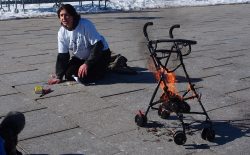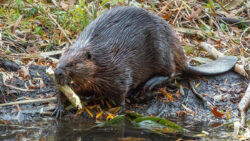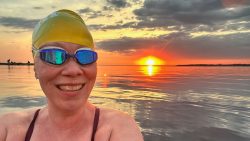The Rideau Valley Conservation Foundation has received a $30,000 grant from the City of Ottawa to begin an expansion of its Nature for All project creating better access to the Baxter Conservation Area for people living with disabilities .
The project’s first phase saw construction of a boardwalk across a marsh to allow people using wheelchairs or walkers — as well as those with visual impairment — to be better accommodated while enjoying their experience of nature.
Phase 1’s bridge boardwalk and education platforms were completed in 2024. The boardwalk is 100 metres in length and wide enough for two people in wheelchairs remain side by side.
The bridges were built sturdy enough to handle the added weight from wheelchairs, and the educational platforms were made for youth who take part in the RVCF’s education programs.
With Phase 1 complete, there’s more work to be done. Funding for Phase 2 has jumpstarted by the $30,000 municipal grant through a program for community-building projects administered by the city’s rural affairs committee .
While the money covers only a small portion of Phase 2, RCVF Executive Director Diane Downey said it was a good start.
“We’re initiating Phase 2, which is 950 metres of trail and boardwalk from our interpretive centre to (the Phase 1 boardwalk),” Downey said.
She said the main boardwalk across the shoreline marsh was built first because it was a strong fundraising draw and because the project team wanted to complete the most important part of making the area accessible at the outset.
Now that the showcase boardwalk has been completed, Downey said making the path to that accessible boardwalk more accessible is a priority. The trail can’t be improved without funding, though, which is why the city grant is key.
“The projected cost in terms of materials is over $675,000 to do the work. The city’s generous donation will help us construct about 64 metres of boardwalk,” said Downey. “So we’re going to attack it incrementally if we can, as funders step up. We’re looking for business partners and donors, but we’re certainly also looking for those grant opportunities from the government to help support the work.”
A city spokesperson said the grant was approved unanimously.
“The City granted $30,000 to RVCF to establish a new accessible outdoor boardwalk at Baxter Conservation Area,” a spokesperson told Capital Current. “This replaces the existing bridge that has fallen into disrepair and was not an accessible structure. This project will support community building by making these amenities at Baxter Conservation Area accessible for all to enjoy.”
The changes taking place at Baxter Conservation Area in south Ottawa are being driven by the facility’s Nature for All committee. Nature for All I has the goal of improving access to conservation areas and inspiring a love of nature.
Mike Nemesvary is a cofounder of Nature for All. He said he helped launch the committee because of his own love of immersing in nature.
We wanted to be able to appeal to people who are deaf, to people who are blind. We wanted to make things very tactile for people who are blind and have audio so people can go to the website and get a talking tour to follow along. We try to appeal to as many different groups with all areas of disabilities.
— Mike Nemesvary, co-founder, Nature For All initiative at Baxter Conservation Area
Nemesvary, a pioneering freestyle skier in the 1970s and 1980s, became a paraplegic following a 1985 trampoline training accident. He said people with mobility challenges should be able to safely enjoy nature and the Baxter Conservation Area is close to his heart.
“Me and my partner have been going there for the better part of 20 years,” said Nemesvary. “We’ve always loved it, but it was always under-utilized and it wasn’t nearly as accessible as it could be. But the potential was obvious from the start.”
He said that, although the shoreline park is one of the most beautiful parts of Ottawa, it wasn’t always well maintained and was initially unsafe for him in his wheelchair. That situation spawned Nature for All and planning for the Phase 1 changes at Baxter soon followed.
Nemesvary said that what usually keeps people with disabilities away from nature is fear of the unknown or fear of getting stuck. He said individuals getting out of their comfort zone is important, and that’s a key reason for the accessibility improvements at the conservation area.
So how do Nature for All and RVCF decide what makes a conservation area more accessible? A lot of the changes, Nemsvary said, were planned following practical test visits to determine what improvements would be needed to make it easier for those living with disabilities to move around the place.
“We wanted to be able to appeal to people who are deaf, to people who are blind. We wanted to make things very tactile for people who are blind and have audio so people can go to the website and get a talking tour to follow along,” said Nemesvary. “We try to appeal to as many different groups with all areas of disabilities.”
As for the Baxter Conservation Area, there are plans for more accessibility improvements in an eventual Phase 3. Nemesvary said he hopes to make the area the most accessible nature attraction in Canada.




